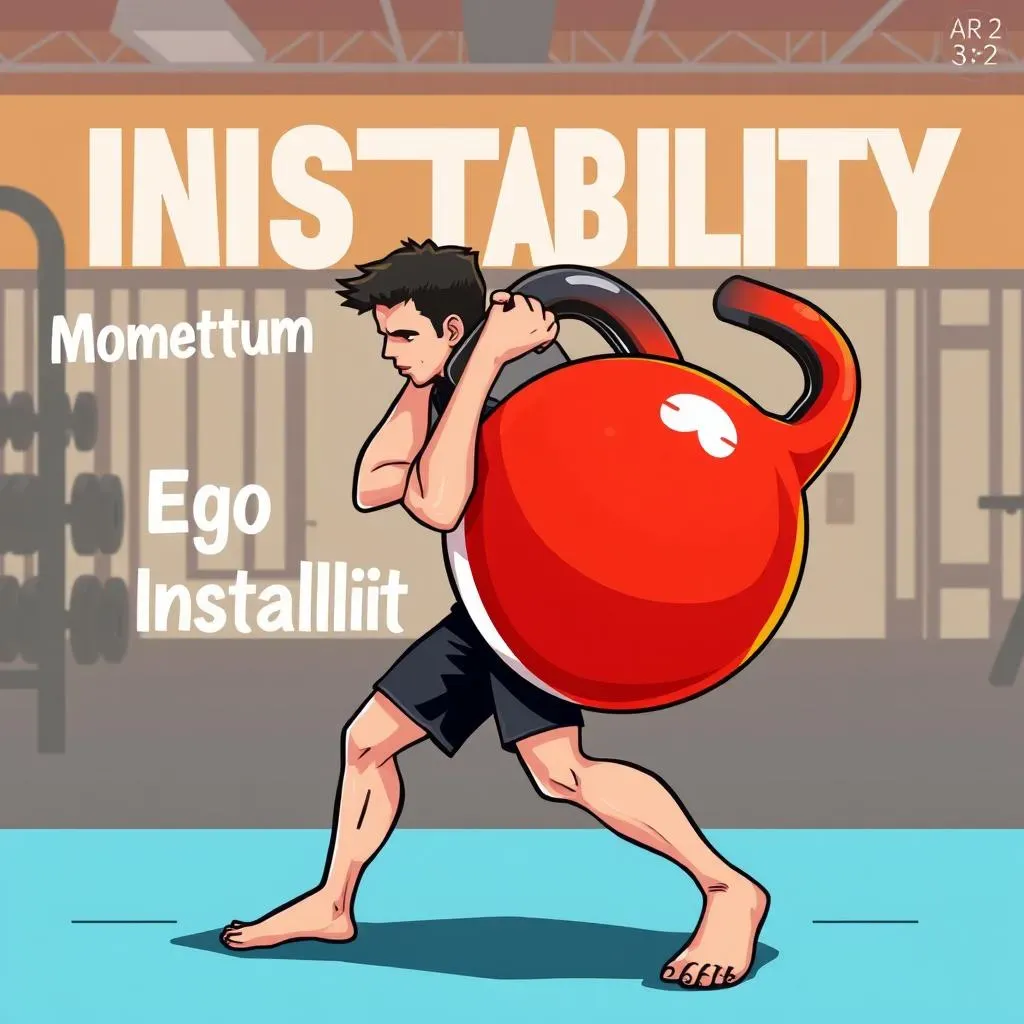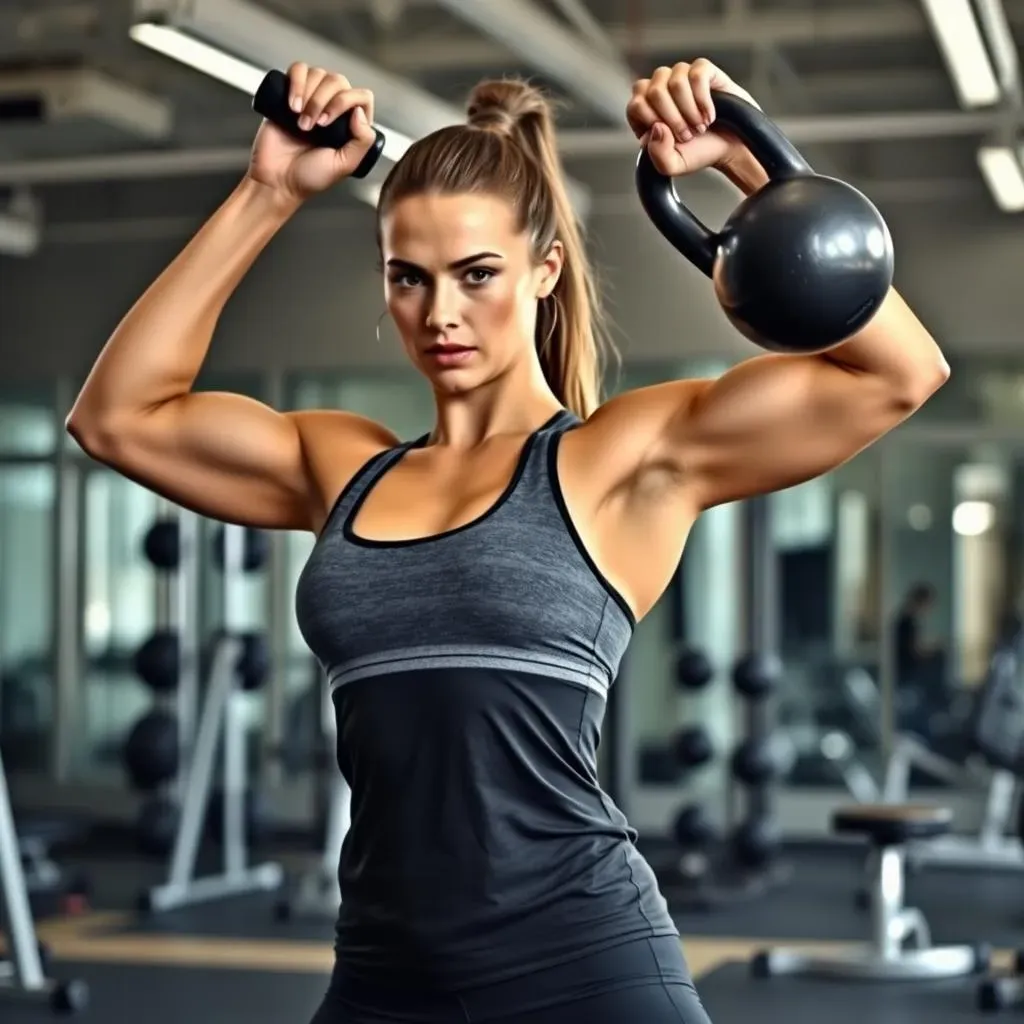Table of Contents
Tired of the same old dumbbell routine? Want to sculpt strong, functional shoulders that not only look great but also improve your overall fitness? Then it's time to pick up a kettlebell! The kettlebell shoulder raise is a fantastic exercise that can add a new dimension to your shoulder workouts. Unlike dumbbells, kettlebells offer an offset load, which engages your stabilizer muscles and challenges your shoulders in a unique way. This article will guide you through everything you need to know about the kettlebell shoulder raise, from proper form and technique to variations and common mistakes to avoid. We'll explore why kettlebells are superior for shoulder development, providing step-by-step instructions, and offering tips for seamlessly integrating this exercise into your current routine. Get ready to unlock a new level of shoulder strength and stability with the power of the kettlebell!
Why Choose Kettlebells for Shoulder Raises?

Why Choose Kettlebells for Shoulder Raises?
Unstable Load, Real Results
so you're thinking about shoulder raises, and maybe you're used to dumbbells. That's cool, but let's talk about why kettlebells are a game-changer. It all boils down to the offset load. A kettlebell's weight isn't evenly distributed like a dumbbell. This means your muscles have to work harder to stabilize the weight throughout the entire movement. This instability isn't a bug; it's a feature! It forces your shoulder muscles, especially those smaller stabilizers, to fire up and work overtime. Think of it like this: dumbbells are like driving on a smooth highway, while kettlebells are like off-roading. Both get you there, but one builds a heck of a lot more resilience.
More Than Just Deltoids: Engaging the Whole Chain
It's not just about your deltoids (the main shoulder muscles). The kettlebell shoulder raise engages your entire kinetic chain – from your grip to your core. When you're fighting to control that swinging kettlebell, your core is working overtime to keep you stable. Your grip strength is also getting a serious workout. This full-body engagement translates to better overall strength and stability, which is super important for everything from sports to everyday activities. Plus, who doesn't want a stronger grip? Seriously, try opening a pickle jar after a few sets of these – you'll feel like a superhero.
Functional Strength for the Real World
Let's be honest, most of us aren't bodybuilders just trying to isolate muscles for aesthetic purposes. We want functional strength – strength that translates to real-life activities. The kettlebell shoulder raise is a functional exercise because it mimics real-world movements. Think about lifting a bag of groceries, hoisting a suitcase into an overhead compartment, or even just reaching for something on a high shelf. These are all movements that require shoulder strength and stability. By training with kettlebells, you're not just building muscle; you're building practical, usable strength that will make your life easier and less prone to injury. So ditch the isolation exercises and embrace the power of functional training!
Mastering the Kettlebell Shoulder Raise: StepbyStep

Mastering the Kettlebell Shoulder Raise: StepbyStep
The Starting Position: Foundation is Key
Alright, let's get down to the nitty-gritty. Proper form is paramount, especially when you're dealing with the offset load of a kettlebell. Start by standing with your feet shoulder-width apart, core engaged, and back straight. Think about rooting your feet into the ground – you want a solid base. Now, grab a kettlebell with one hand. The kettlebell should be hanging just in front of your thigh, palm facing your body. This is your starting position. Make sure you're not slouching or leaning to one side. Good posture is key to preventing injuries and maximizing the effectiveness of the exercise. Imagine a string pulling you up from the crown of your head. That's the kind of upright posture you're aiming for.
The Raise: Controlled Ascent
Now for the main event – the raise itself. Keeping your core tight, slowly raise the kettlebell out to the side, away from your body. Your arm should be mostly straight, but don't lock out your elbow. Aim to raise the kettlebell until your arm is parallel to the ground, or slightly below shoulder height. The key here is control. Don't just swing the kettlebell up. Focus on using your shoulder muscles to lift the weight. Pay attention to how your shoulder feels. You should feel the muscles working, but you shouldn't feel any pain. If you do feel pain, stop immediately and check your form. It's better to use a lighter weight and maintain good form than to try to lift too heavy and risk injury.
The Descent: Slow and Steady Wins the Race
What goes up must come down, right? But the descent is just as important as the ascent. Slowly lower the kettlebell back to the starting position, maintaining control throughout the entire movement. Resist the urge to just let the kettlebell drop. This is where you'll really feel those stabilizer muscles working. Focus on keeping your core engaged and your back straight. Repeat for the desired number of repetitions, then switch to the other arm. Remember, consistency is key. Aim for quality over quantity. It's better to do a few perfect reps than a bunch of sloppy ones. And don't forget to breathe! Inhale as you lower the kettlebell, and exhale as you raise it.
Step | Action | Focus |
|---|---|---|
1 | Starting Position | Feet shoulder-width, core engaged, back straight, kettlebell in one hand. |
2 | The Raise | Slow, controlled lift to parallel, using shoulder muscles. |
3 | The Descent | Slow, controlled lowering to starting position, engaging stabilizers. |
Kettlebell Shoulder Raise Variations for Targeted Growth

Kettlebell Shoulder Raise Variations for Targeted Growth
Front Raise Focus
Alright, so you've nailed the basic kettlebell shoulder raise. Now it's time to spice things up and target specific areas of your shoulders. Let's start with the front raise variation. Instead of raising the kettlebell out to the side, you're going to raise it straight in front of you. This variation really hammers the anterior (front) deltoid. The setup is the same: feet shoulder-width apart, core engaged, back straight. But this time, grip the kettlebell with both hands, letting it hang in front of your thighs. Now, keeping your arms mostly straight, raise the kettlebell up until it's about shoulder height. Focus on using your front deltoids to lift the weight. Control the movement on the way down, and repeat. You'll feel the burn, trust me!
Why do this variation? Because most shoulder exercises tend to hit the medial (side) and posterior (rear) deltoids more. The front deltoid often gets neglected. This exercise helps to balance out your shoulder development, leading to a more well-rounded and aesthetically pleasing physique. Plus, stronger front deltoids can improve your performance in exercises like bench press and overhead press. It's a win-win!
Lateral Raise Domination
Next up, we have the lateral raise variation. This is similar to the standard kettlebell shoulder raise, but with a slight tweak to maximize engagement of the medial (side) deltoid. Instead of just raising the kettlebell straight out to the side, you're going to slightly angle your arm forward, as if you're pouring a pitcher of water. This subtle change in angle really targets the side deltoids, helping to build width and definition in your shoulders. The setup is the same as the standard raise, but remember to focus on that slight forward angle. As you raise the kettlebell, visualize pouring that pitcher of water. This will help you maintain the correct form and maximize the effectiveness of the exercise. Control the movement on the way down, and repeat. Get ready to feel the burn in your side deltoids!
This variation is fantastic for building that coveted "capped" shoulder look. Strong side deltoids also improve your shoulder stability and reduce your risk of injury. So if you're looking to build wider, stronger, and more resilient shoulders, the lateral raise variation is a must-add to your routine.
Variation | Target Area | Key Technique |
|---|---|---|
Front Raise | Anterior (Front) Deltoid | Raise kettlebell straight in front, using both hands. |
Lateral Raise | Medial (Side) Deltoid | Slight forward angle, visualize pouring water. |
Common Mistakes to Avoid in the Kettlebell Shoulder Raise

Common Mistakes to Avoid in the Kettlebell Shoulder Raise
Swinging the Weight: Momentum vs. Muscle
One of the most common mistakes I see is people swinging the kettlebell up instead of using their shoulder muscles. This turns the exercise into a momentum-driven movement, which defeats the purpose and reduces its effectiveness. You're not trying to see how high you can swing the weight; you're trying to isolate and strengthen your shoulder muscles. Focus on controlling the kettlebell throughout the entire range of motion. If you find yourself swinging, it's a sign that the weight is too heavy. Drop down to a lighter kettlebell and focus on proper form. Remember, it's better to do fewer reps with good form than a bunch of reps with sloppy form.
Think about it like this: swinging is like cheating on a test. You might get away with it in the short term, but you're not actually learning anything. Using your muscles to lift the weight is like studying for the test. It's harder, but you'll actually learn something and improve your strength in the long run.
Using Excessive Weight: Ego vs. Exercise
Another big mistake is using too much weight. We all want to lift heavy and feel strong, but ego lifting can lead to injuries and poor form. The kettlebell shoulder raise is not about lifting the heaviest weight possible; it's about controlled movement and engaging the correct muscles. If you can't maintain proper form throughout the entire exercise, the weight is too heavy. It's better to start with a lighter weight and gradually increase it as you get stronger. Focus on mastering the movement before you start adding weight. Your shoulders will thank you for it!
I've seen people try to muscle up weights that are clearly too heavy for them. Their form goes out the window, their faces turn red, and they're basically just flailing around. It's not pretty, and it's definitely not effective. Leave your ego at the door and focus on proper form. Your shoulders will grow stronger and healthier in the long run.
Neglecting Core Engagement: Stability is Strength
Finally, many people neglect to engage their core during the kettlebell shoulder raise. This is a crucial mistake because your core provides stability and support for your entire body. Without a strong core, you're more likely to sway, lean, and lose control of the kettlebell. Engage your core by tightening your abdominal muscles as if you're about to be punched in the stomach. This will help to stabilize your spine and prevent injuries. Think of your core as the foundation of a house. If the foundation is weak, the whole house will crumble. The same is true for your body. A strong core is essential for proper form and injury prevention.
Seriously, try doing a kettlebell shoulder raise without engaging your core. You'll feel wobbly and unstable. Now, try it with your core engaged. You'll feel much more solid and in control. It's like night and day. So don't forget to engage your core! It's a small detail that makes a big difference.
Mistake | Why it Matters | Solution |
|---|---|---|
Swinging the Weight | Reduces muscle engagement, increases risk of injury. | Use lighter weight, focus on controlled movement. |
Using Excessive Weight | Compromises form, increases risk of injury. | Use lighter weight, prioritize proper form. |
Neglecting Core Engagement | Reduces stability, increases risk of injury. | Actively engage core muscles throughout the exercise. |
Integrating the Kettlebell Shoulder Raise into Your Workout Routine

Integrating the Kettlebell Shoulder Raise into Your Workout Routine
Finding the Right Fit: Placement Matters
Alright, so you're sold on the kettlebell shoulder raise. Now, where do you actually put it in your workout routine? The beauty of this exercise is its versatility. You can incorporate it into your warm-up, your main workout, or even as a finisher. If you're using it as a warm-up, stick to lighter weights and higher reps to get the blood flowing to your shoulder muscles. If you're using it as part of your main workout, you can go heavier and focus on lower reps for strength gains. And if you're using it as a finisher, try doing a few sets to failure to really burn out those shoulders. The key is to listen to your body and adjust accordingly. Don't be afraid to experiment and find what works best for you. There's no one-size-fits-all approach to fitness.
Personally, I like to incorporate the kettlebell shoulder raise into my shoulder day routine. I'll usually do a few sets of the standard raise, followed by a few sets of the front raise and lateral raise variations. This allows me to target all three heads of my deltoids for balanced shoulder development. I also like to throw in some other kettlebell exercises, like the kettlebell press and kettlebell snatch, to work my shoulders from different angles. Variety is the spice of life, and it's also the key to preventing plateaus and keeping your workouts engaging.
Sets, Reps, and Rest: The Magic Numbers
So, what about sets, reps, and rest? Again, it depends on your goals. If you're aiming for strength gains, try doing 3-4 sets of 8-12 reps with a heavier weight. If you're aiming for muscle endurance, try doing 2-3 sets of 15-20 reps with a lighter weight. And if you're using it as a warm-up, try doing 1-2 sets of 20-25 reps with a very light weight. As for rest, aim for 60-90 seconds between sets for strength gains, and 30-60 seconds between sets for muscle endurance. The key is to find a balance between challenging yourself and allowing your muscles to recover. Don't be afraid to adjust the numbers based on how your body feels. Some days you'll be able to lift heavier and do more reps, and other days you'll need to scale back. Listen to your body and respect its limits.
I know it can be tempting to just copy what you see other people doing, but remember that everyone is different. What works for one person might not work for you. Experiment with different sets, reps, and rest periods until you find what feels best and produces the results you're looking for. And don't be afraid to ask for help from a qualified fitness professional. They can assess your individual needs and goals and create a personalized workout plan that's tailored to you.
Goal | Sets | Reps | Rest |
|---|---|---|---|
Strength | 3-4 | 8-12 | 60-90 seconds |
Endurance | 2-3 | 15-20 | 30-60 seconds |
Warm-up | 1-2 | 20-25 | Minimal |
Conclusion: Elevate Your Shoulder Game with the Kettlebell Shoulder Raise
The kettlebell shoulder raise is more than just an exercise; it's a gateway to stronger, more functional shoulders. By understanding the nuances of kettlebell training and applying the techniques discussed, you can effectively target and develop your shoulder muscles while improving stability and overall performance. Remember to prioritize form over weight, listen to your body, and gradually increase the challenge as you progress. Incorporate the kettlebell shoulder raise and its variations into your routine, and you'll be well on your way to achieving the shoulder strength and physique you've always wanted. So, grab that kettlebell and start raising the bar – literally!